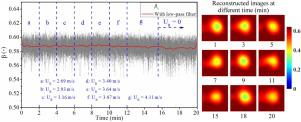Particuology ( IF 4.1 ) Pub Date : 2019-12-25 , DOI: 10.1016/j.partic.2019.11.003 Zhan Luo , Yonglei Lin , Qiuya Tu , Wuqiang Yang , Haigang Wang

|
The flow characteristics of a dual fluidised bed gasifier (DFBG) are more complex than those of a single fluidised bed gasifier. For stable operation and appropriate control, a cold DFBG test facility with both an upper and a lower U-valve was built, and electrical capacitance tomography (ECT) sensors were installed with pressure transducers to investigate the effects of operating conditions on gas‒solids flow hydrodynamics. The operating parameters included gas velocities in the riser and in the bubbling fluidised bed, aeration velocity in the lower U-valve, bed material inventory, and particle size. This is the first time that ECT was applied in different flow zones of a dual fluidised bed gasifier system. The experimental results indicated that ECT in the recycle chamber could monitor the performance of the lower U-valve under different operating conditions for early detection of gas shortcut from the riser to the bubbling bed. Three main flow regimes in the riser and the differences between the reactors were identified by two sets of ECT sensors with pressure transducers. Finally, the effects of the operating conditions on the pressure drop in different parts of the DFBG was investigated.
中文翻译:

利用电容层析成像传感器研究双流化床气化炉冷模型中气固两相流的流体动力学
双流化床气化炉(DFBG)的流动特性比单流化床气化炉的流动特性更为复杂。为了稳定运行并进行适当控制,建造了带有上下U阀的冷DFBG测试设施,并安装了带有压力传感器的电容层析成像(ECT)传感器,以研究工作条件对气固流的影响流体动力学。操作参数包括提升管和鼓泡流化床中的气体速度,下部U阀中的充气速度,床料存量和粒径。这是ECT首次应用于双流化床气化炉系统的不同流动区域。实验结果表明,再循环室中的ECT可以在不同的操作条件下监视下部U阀的性能,以及早发现从立管到冒泡床的气体捷径。两组带有压力传感器的ECT传感器可识别出立管中的三种主要流动方式以及反应器之间的差异。最后,研究了运行条件对DFBG不同部分压降的影响。











































 京公网安备 11010802027423号
京公网安备 11010802027423号